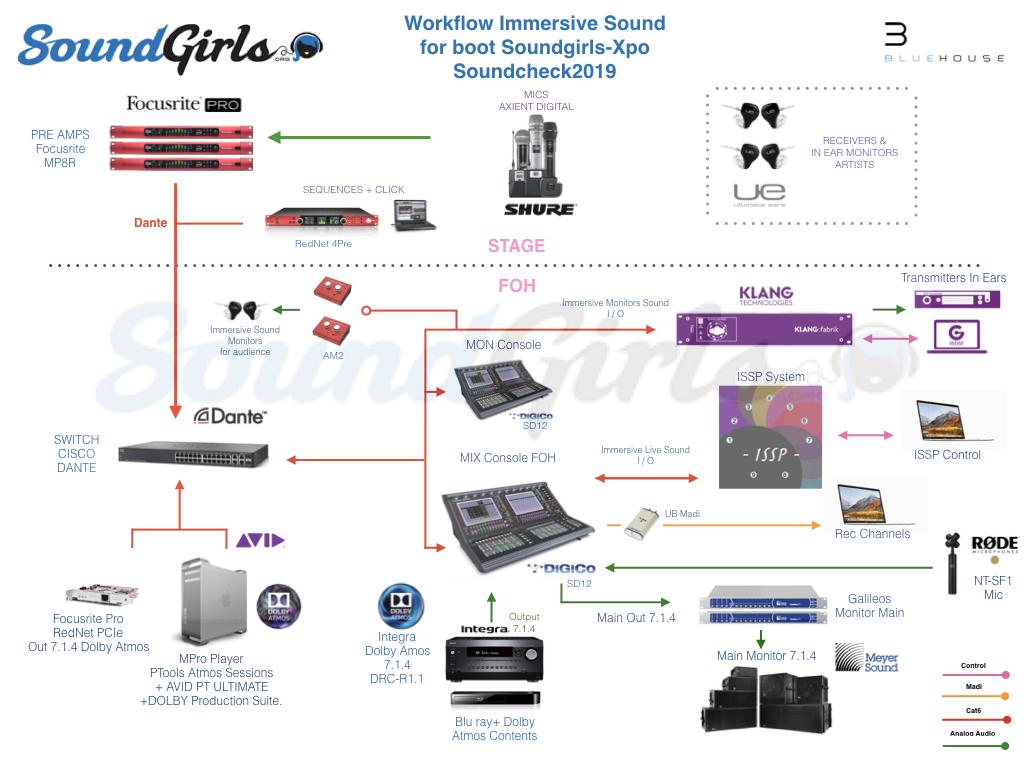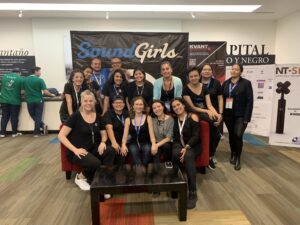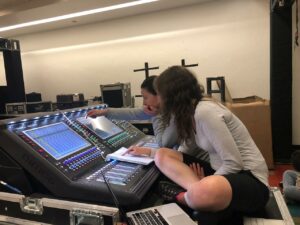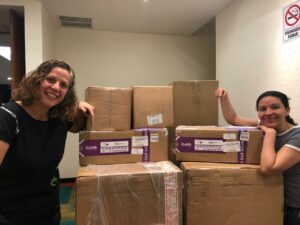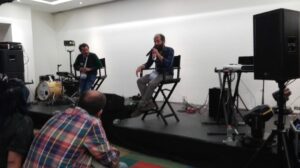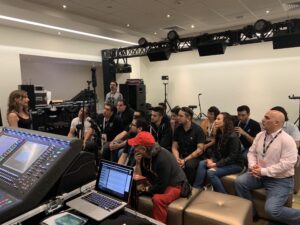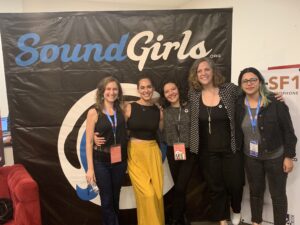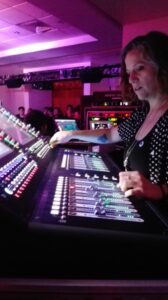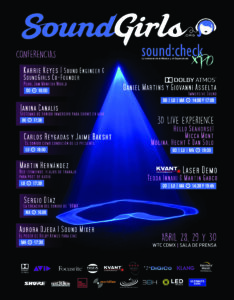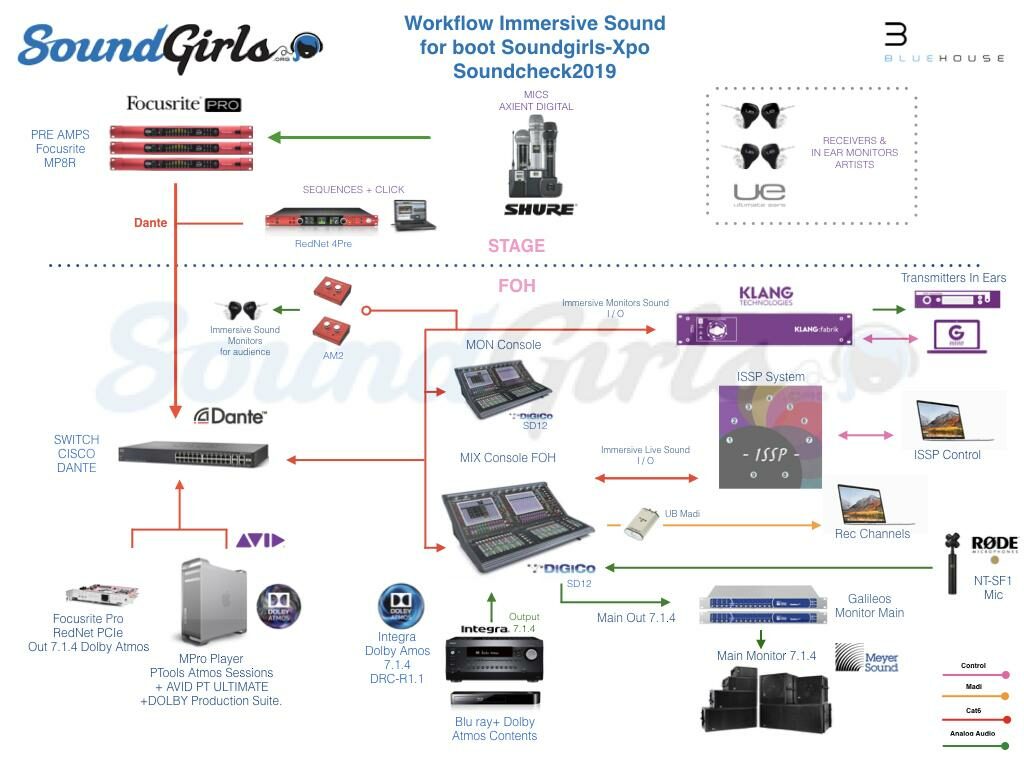SoundGirls is a non-profit organization that seeks to generate a professional network to support mainly women since statistically, we represent the 5 percent of women working in professional music and production industry.
This year, SoundGirls in Mexico broke paradigms and prejudices, thanks to the union of people who chose to break mental boundaries and bet on the path of art, creation, and technology. We wish to thank our sponsors Digico, Klang, Meyer Sound, Dolby, and sound: check Xpo.
Every year since 2015, SoundGirls has been awarded a space within the most important event in the industry currently in Latin America: sound: check Xpo. Thanks to the general director, Jorge Urbano, we have been able to host creators and different experiences for members of the organization and the general public, without distinction of gender.
SoundGirls Mexico started inside sound: check Xpo with a very small space, enough to start the call in CDMX. Each year we have given ourselves the task of generating innovative and unique spaces, being pioneers in the implementation of technology and art, proposing a different theme in each of our participation.
Four years later we are a much stronger structure, and with the help of a team of professionals within the industry, and the support of professional companies as sponsors, we managed to provide an experience with the theme “Immersive Sound.”
Since November 2018, an unconventional idea began, which was to present new technology in Mexico, coupled with the implementation of protocols not used or currently explored in Latin America.
The first challenge was to have the support of companies that carried out the import of the necessary equipment for such an ambitious project. Little by little, the general idea was landed, which was to show immersive sound formats (360 degrees, 3D and Atmos), applied mostly for live sound.
Since we wanted to focus on live sound, the immersive world of monitors was controlled by KLANG, to provide personalized monitoring to the musicians in a binaural format with 3D sound. When I started to think about the mix format for FOH, I faced the biggest challenge in this project, since unfortunately none of the recognized brands within the live immersive sound market wanted to participate, but this was not an obstacle, and I followed with the original idea without diverting my main objective: to make and mix for the first time in Mexico a live show using immersive sound.
In mid-February, the team of Dolby.lab Brazil, headed by Daniel Martins, along with Daniel Castillo, joined the project, allowing us to work with a special and unique team. Marina Bello (sound engineer), confirmed her assistance as a guide and was in charge of monitors, and as she became more involved in the project, she connected me with Ianina Canalis, an Argentinean sound engineer who has programmed and designed software to mix FOH in an immersive format applied to live sound (ISSP).
Immediately I contacted Ianina to discuss SoundGirls, and I was surprised to know that she was already a member of the organization for several years. After the Mexico-London videoconferences, it was decided that Ianina would travel to Mexico to present her software (ISSP) and be part of a unique event: mixing for the first time in Mexico and Latin America live sound with an immersive system. Ianina joined the team and was included in the lectures. Check out ISSP here
Shortly afterward, a petition for volunteers inside the booth was launched through the SoundGirls platform, without even saying what would take place inside it. The response was wonderful, many women began to respond to support the event and for the first time, women from the interior of the Mexican Republic and other Latin American countries traveled to Mexico to collaborate
The team of professionals began to be formed, we started collaborative meetings and shared areas of work that would work as guides with the volunteers (a type of mentor for the participants).
The whole month of March, we were in the studio of 3BH to do tests and pre-mix and talk with the adventurous musicians who would play and be mixed in immersive sound. We decided that to maintain a sweet spot or CLA, with greater coverage and greater definition, all instruments should be digital, except for the voice and bass for some musicians. This idea was to avoid the direct sound coming from the stage (noise pollution), and we could mix in an immersive way the most channels in a 360-degree format.
Along with this sound system, specialized design of lasers were showcased, as well as lights and projection, to generate 3D dimensions for the different senses.
The result that was obtained in all the workshops and seminars at the SoundGirls Venue was thanks to the sum of the knowledge of every one of the people that made this great experience possible, which provided new knowledge and technology and a new way to listen and mix live sound.
Specialists, engineers, students, technicians, artists, and speakers contributed in a great way to boost the industry, looking for new forms of art and challenges.
To each and every one of the participants, thank you!
- Ianina Canalis
- Marina Bello
- Marina Bello
I want to share with you the fundamental stage that would make sure the entire system would work together. The main challenge for all of us is to unify as much as possible the different immersive sound reproduction systems.
We started with the design of speakers and standards for the different systems:
The standards used in ATMOS (broadcast and cinema) formats are specific and detailed. We must follow a special equalization (depending on the volume of the room), as well as depending on the format (5.1.7.1 & Atmos), we must respect sound pressure by format.
Live Sound – The Immersive System
To have greater coverage, speaker arrays are placed at the same height and distance, preferably from 5 to 7 systems at the front (odd number), with a sound reinforcement on the sides and at the back of the enclosure, covering an area of 360 degrees. Taking this into account, the first thing was to design a system with Dolby.
The sound Design for the venue was designed with Dolby. Using Lab’s Dolby Audio Room Design Tool (DARDT) software, the speaker arrangement was made in 7.1.4. A total of twelve loudspeakers with discrete outputs (independent signal) were used. Meyer Sound MAPP software was used for the system. Basically, the difference between one and the other was to change the center speaker, for Dolby, it must be at listening height (1.20 meters). For live sound, we used a system suspended in front of the stage, together with the other PA points.
For the processing of the signal, we use two Galileos (Meyer Sound), in which snapshots were programmed to call memories with the different formats that were calibrated, following the corresponding norms (previously mentioned), in this case, 7.1, ATMOS and sound Immersive 360 degrees for the live mix.
Another challenge was not to use an analog snake and replace it with CAT6 ethernet cabling, using REDNET Focusrite interfaces with the digital splitter as preamplifiers, so that our main transmission protocol was DANTE – Audinate, thus avoiding multiple AD / DA conversions.
All the systems were interconnected using a CISCO switch, creating a network where we use all the resources; that is, 64 input channels with 54 digital output channels, to synchronize all the systems, the clock of the FOH (Clock Master) console was used via DANTE.
Pro Tools sessions were reproduced in 7.1 formats and with Dolby Atmos Renderer immersive sound software, to show the home entertainment area, an Integra AV was used to play ATMOS content of a bluray, USB and Apple TV.
In the world of monitors, eight stereo mixes were made with IEM Shure PSM900, using Ultimate Ears IEMS and the binaural 3D KLANG system was used. It is important to mention that no floor monitors were used and the audience had access to an immersive mix using AM2 interfaces from Focusrite.
Finally, a multi-track recording of all the input channels was made, along with an Ambisonics Rode NT-SF1 microphone through UBMADI, using Digico SD12 consoles with DANTE DMI card and a D2 Rack. The wireless microphone system was SHURE AXIEN DIGITAL.
Diagram of the signal flow.
